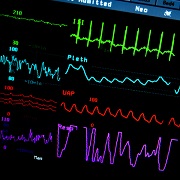Mobile Telestroke Units to Hit the Road in Chicago
Two Chicago-area health systems will soon deploy specially-equipped telestroke vans capable of diagnosing and treating stroke victims before they're taken to a hospital.

- Chicago is taking telestroke directly to the patient, with the deployment over the next few months of two specially equipped mobile vans.

Northwest Medicine Central DuPage Hospital is scheduled to launch the first vehicle this month, and Rush University Medical Center is expected to have its unit on the road within two months. Each looks like an ambulance, and carries a portable CT scanner, supplies of the clot-busting drug tPA (tissue plasminogen activator) and a telemedicine link to the health system.
While in-hospital telemedicine platforms have been shown to improve the diagnosis and treatment of stroke cases in small and rural health systems, they only work when the patient is in the hospital or clinic. Recognizing that someone suffering a stroke needs treatment as soon as possible, some health systems are experimenting with mobile telestroke units, especially in heavily congested or remote areas where transport could take an hour or more.
A 2015 study undertaken by the Cleveland Clinic and the Cleveland Emergency Medical Service and reported in JAMA Neurology found that a mobile telestroke service could cut at least five minutes off the time needed to give a patient a CT scan, while it could shave 26 minutes off the time taken to administer tPA.
“Our data demonstrated that the evaluation and treatment were not only comparable to ED times but also shorter in terms of CT, laboratory processing and thrombolytic administration,” the JAMA article stated. “Intravenous thrombolysis was successfully administered to 48.5 percent (16 of 33) of patients with suspected stroke and was delivered quickly in the [mobile telestroke unit]. The shortest time from the door to IV-tPA administration was 11 minutes, which highlights the potential application of [mobile telestroke] in delivering early thrombolysis to patients with stroke thereby reducing disability.”
Harish Shownkeen, MD, medical director for stroke and neurovascular medicine at Northwest Medicine Central DuPage Hospital, told the Associated Press that mobile telestroke units have the capability of saving lives by enabling emergency personnel to begin care as soon as they reach a patient.
“I think this will be the standard of care as time goes by. It’s a phenomenal technology to have,” he said. “The treatment hasn’t changed; it’s the initiating of the treatment that has made the quantum leap.”
“Time really is of the essence,” added James Conners, MD, section head of cerebrovascular disease at Rush University Medical Center. “For every minute that goes by of a blockage in the brain, you lose about 2 million brain cells.”
The potential is there to save lives: Strokes are the third-leading cause of death in Illinois, according to state figures, and the Chicago Tribune reported that more than 5,300 people died from strokes in Illinois in 2010.
The question is whether the telestroke units are sustainable. The Rush University Medical Center van cost roughly $1 million to outfit and will cost that much to keep on the road each year. Both units are currently funded by grant money.
In addition, the vans are used only for stroke cases, and are sent away (and replaced by an ambulance) in cases where the patient is found to have a medical condition other than a stroke.
One alternative to the van may be a laptop.
Last year, the Atlantic Health System’s Overlook Medical Center in Summit, N.J., found in a two-year study that door-to-needle time was reduced by almost 15 minutes when paramedics used a specially modified tablet that enables video communications with the hospital. Those tablets cost $25,00 apiece and another $5,000 a year to run.
“The training is remarkably straightforward,” John Halperin, MD, chairman of Overlook’s department of neurosciences and lead researcher on the study, told mHealthIntelligence.com. “It’s about 1 percent more complicated than turning on the tablet.”
Dig Deeper:
The Benefits and Challenges of Telehealth for Specialists
How Nighttime Telehealth Services Can Improve Overnight Care
